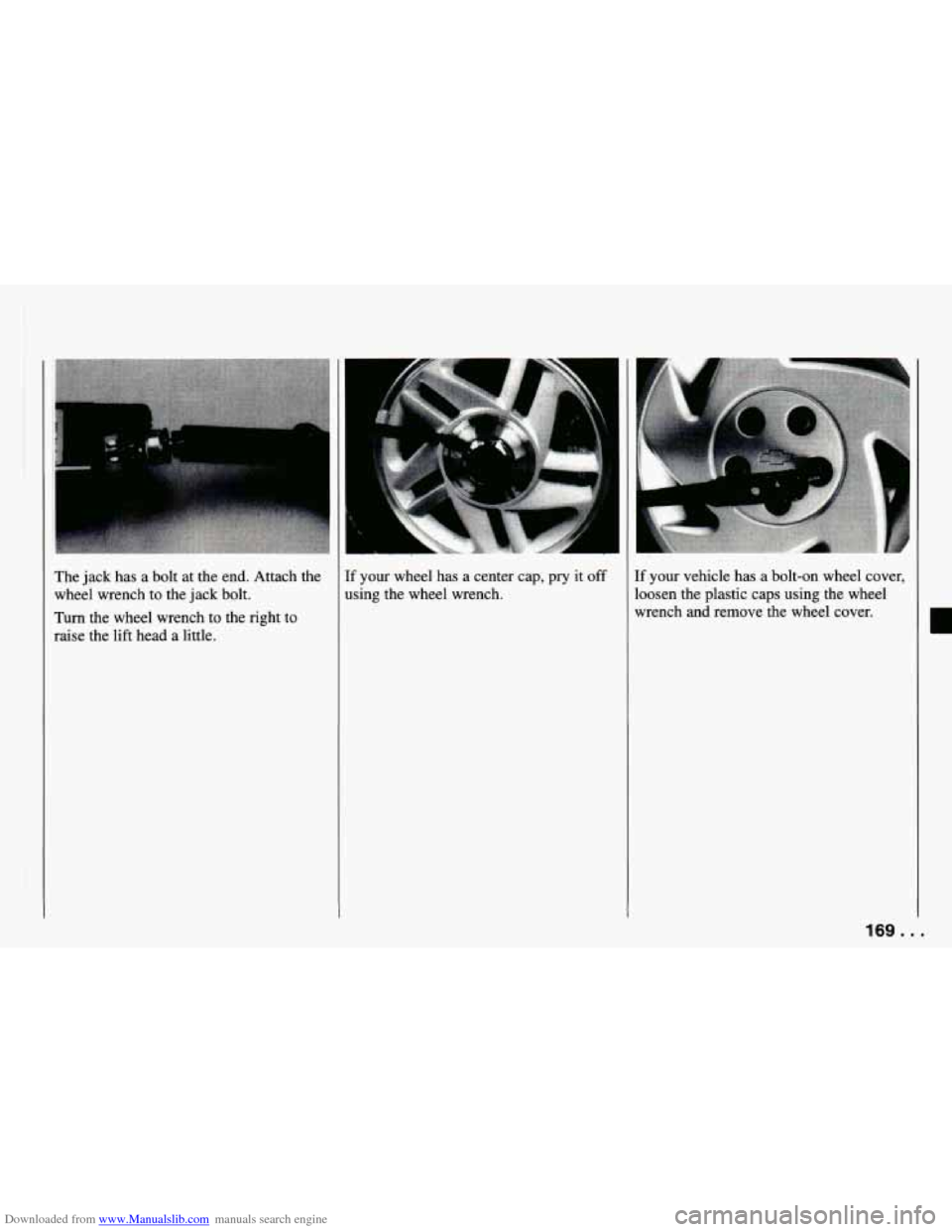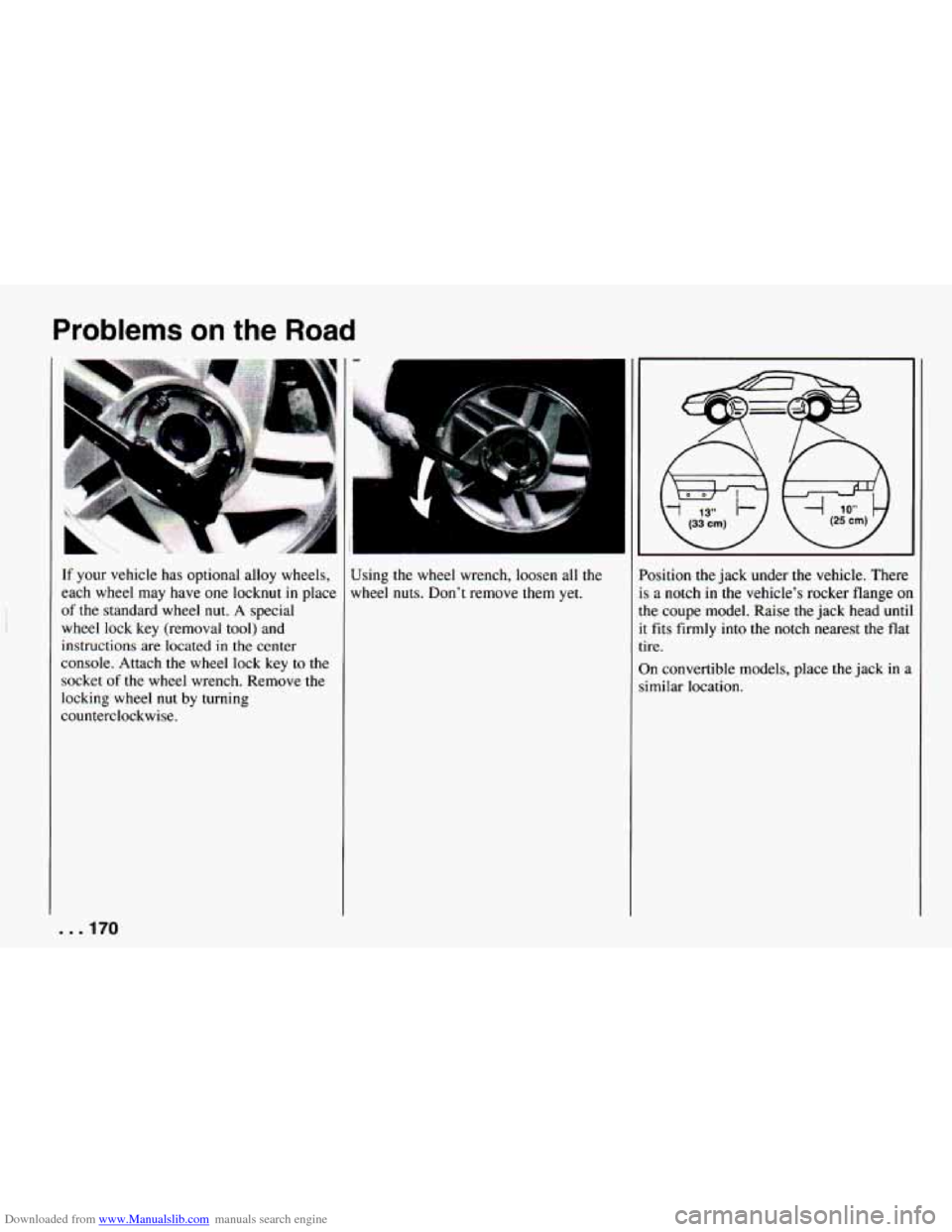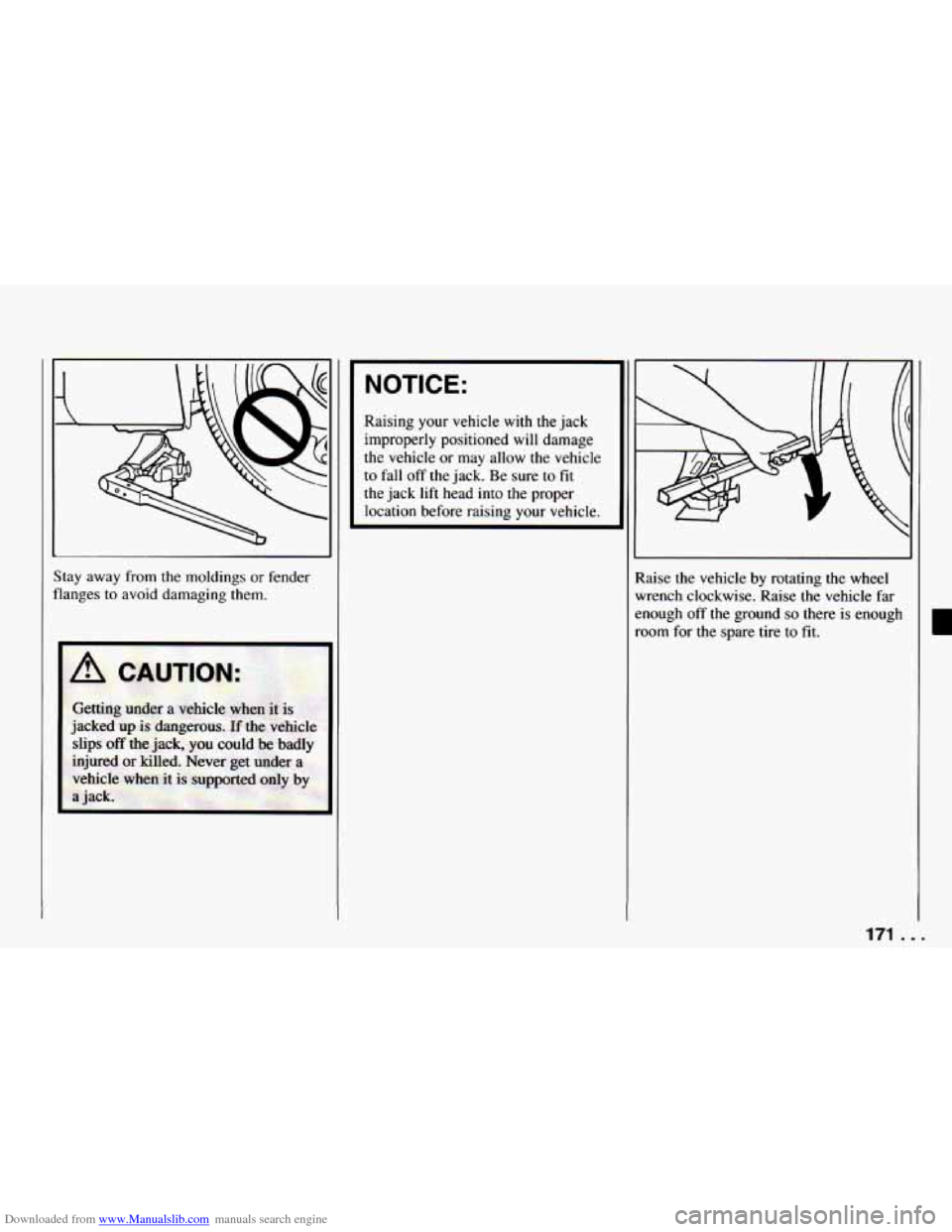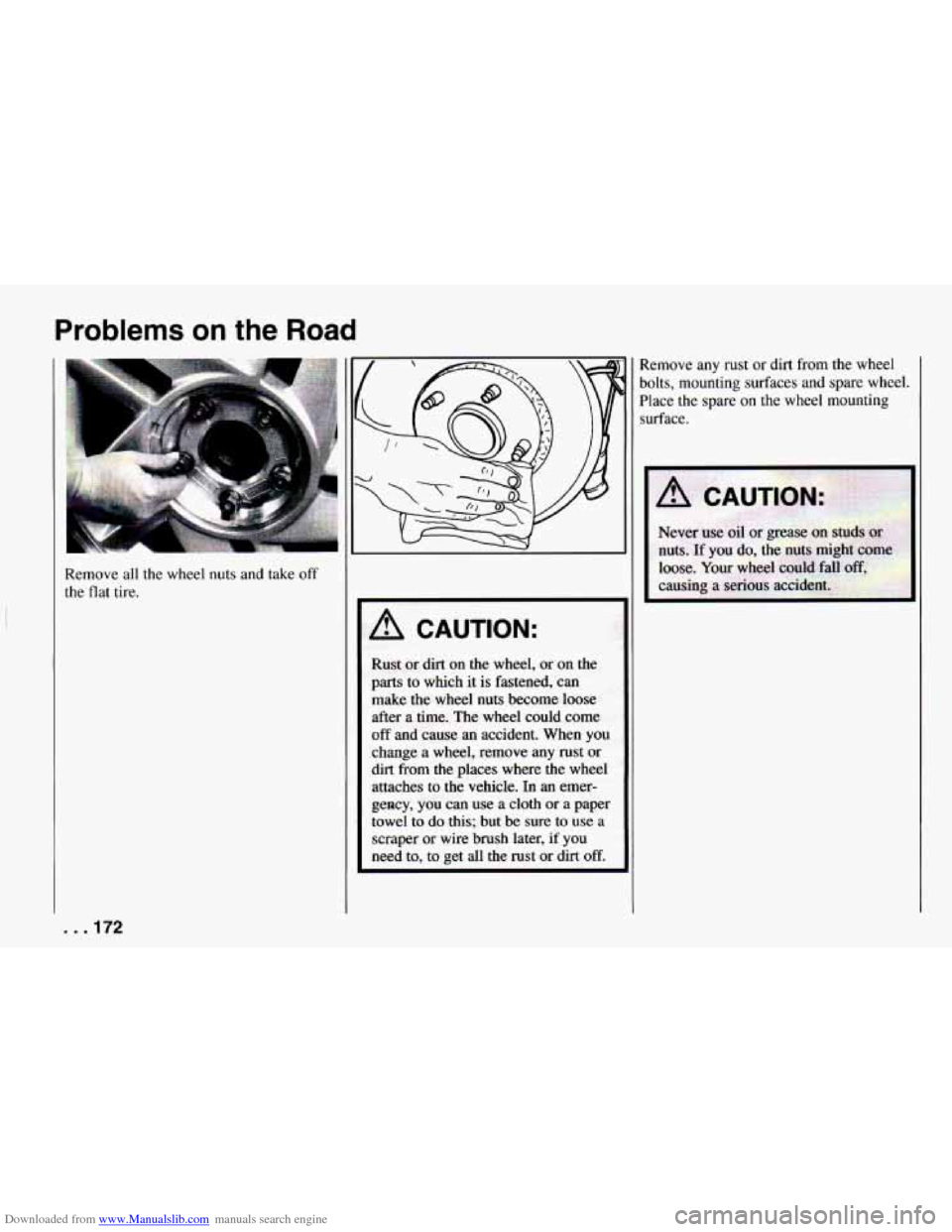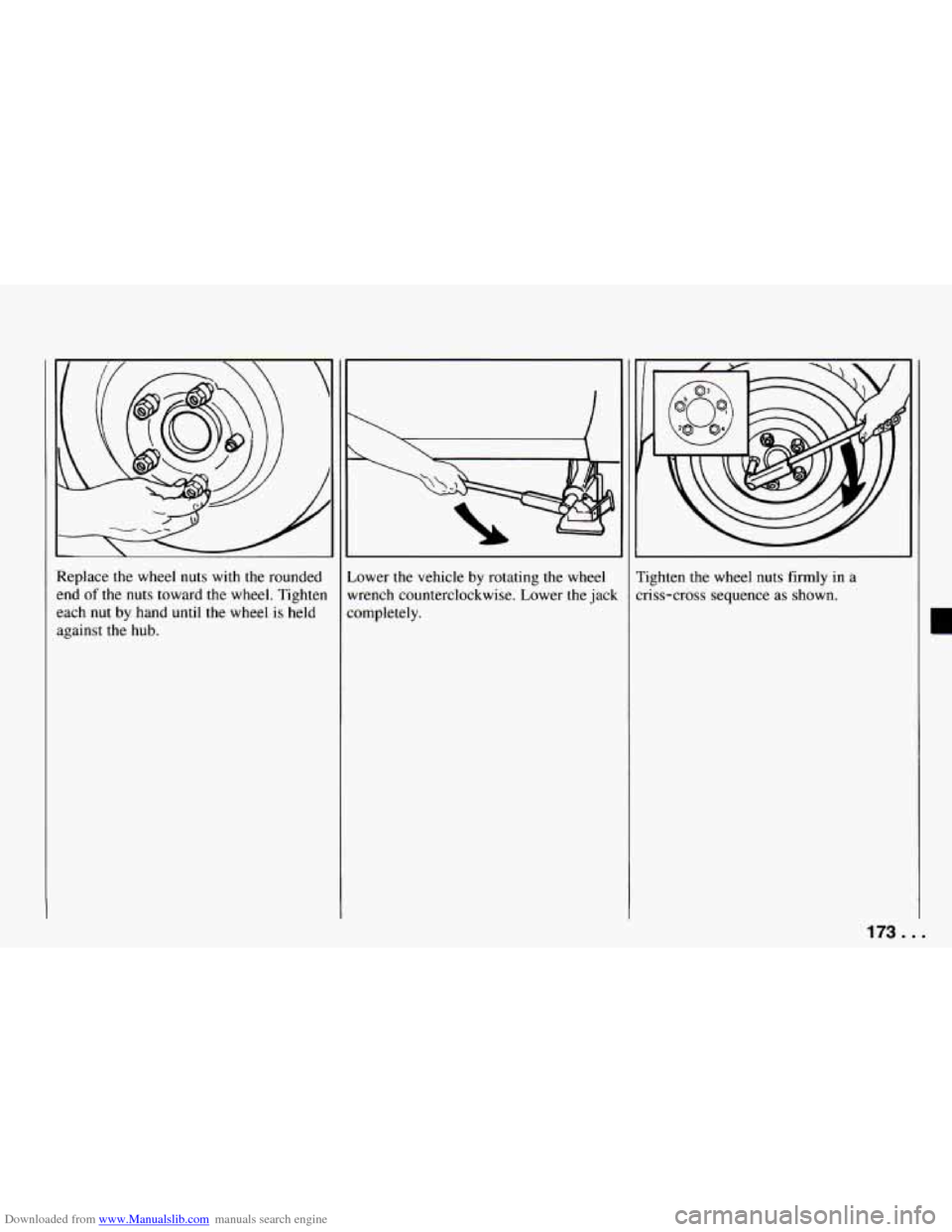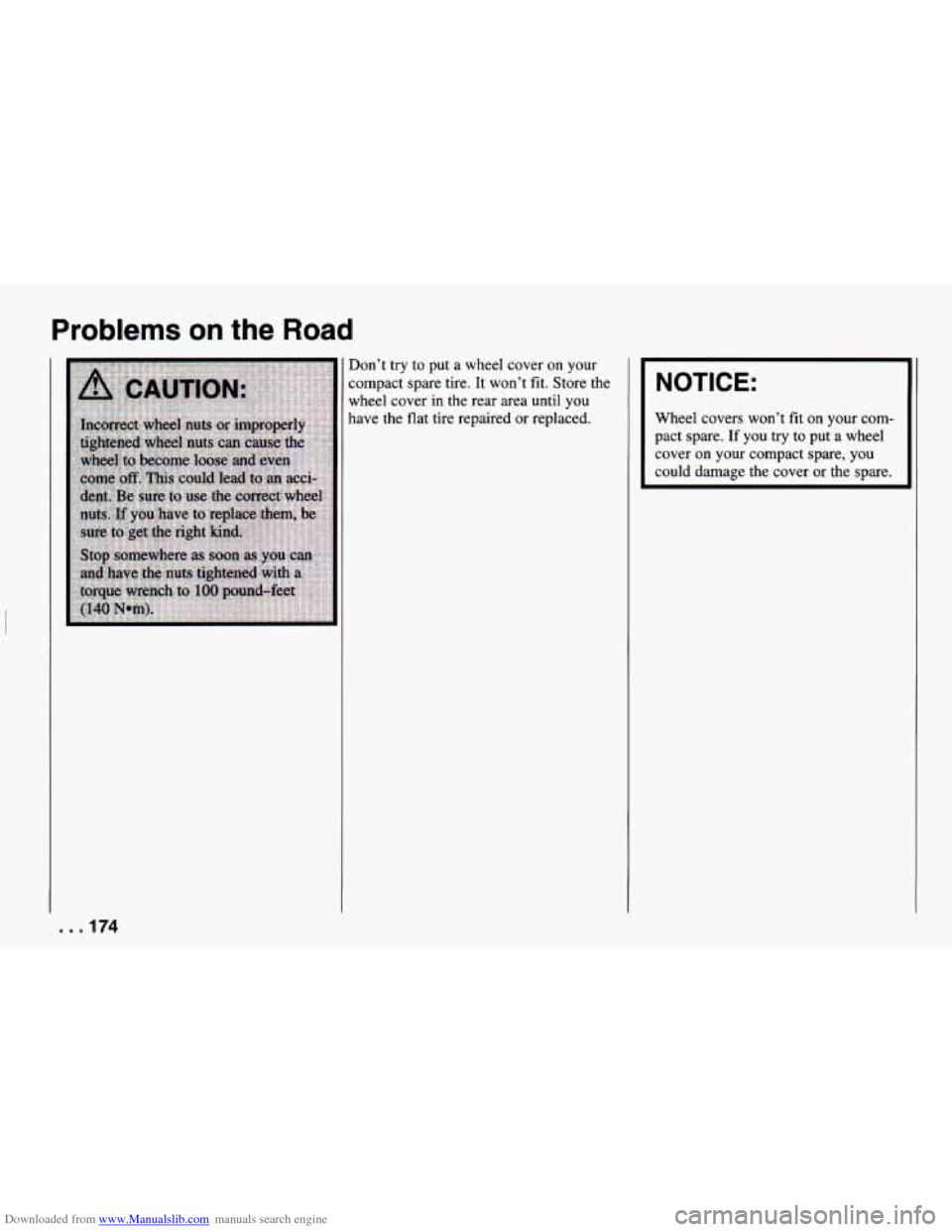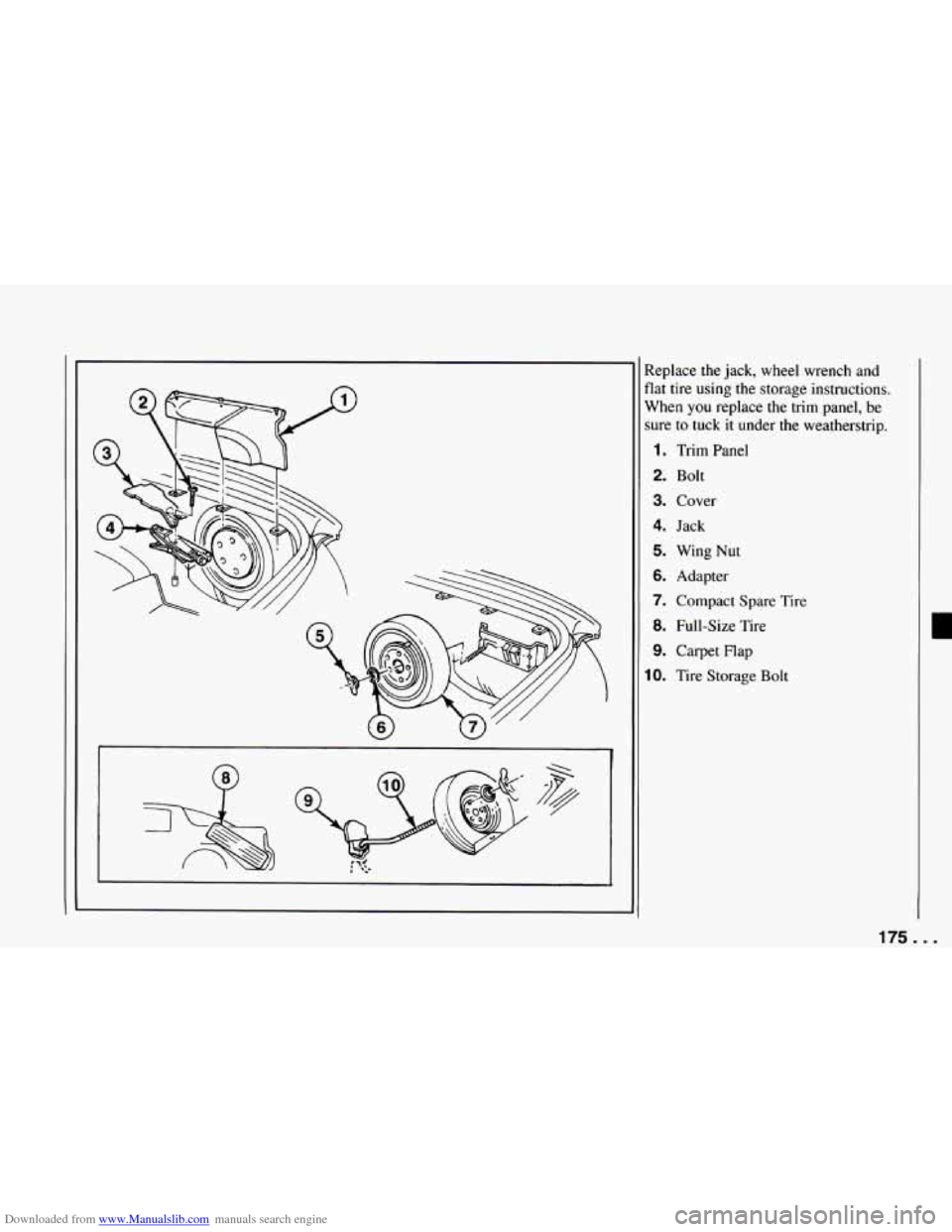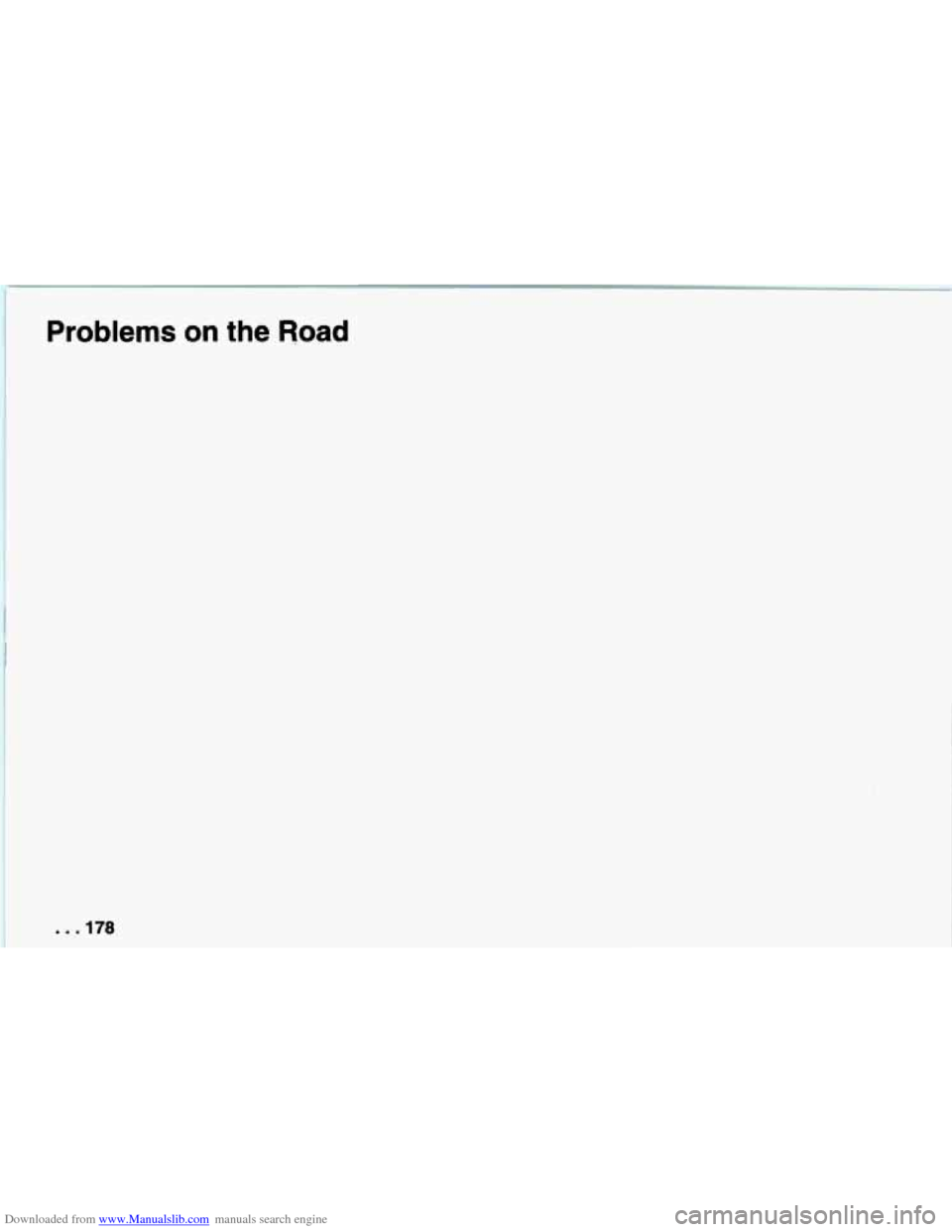CHEVROLET CAMARO 1994 4.G Owners Manual
CAMARO 1994 4.G
CHEVROLET
CHEVROLET
https://www.carmanualsonline.info/img/24/8063/w960_8063-0.png
CHEVROLET CAMARO 1994 4.G Owners Manual
Trending: boot, mirror, belt, start stop button, checking oil, wheel torque, remote control
Page 171 of 292
Downloaded from www.Manualslib.com manuals search engine The jack has a bolt at the end. Attach the
wheel wrench to the jack bolt.
Turn the wheel wrench to the right to
raise the lift head a little.
If your wheel has a center cap, pry it off
using the wheel wrench.
If your vehicle has a bolt-on wheel cover,
loosen the plastic caps using the wheel
wrench and remove the wheel cover.
169 ...
Page 172 of 292
Downloaded from www.Manualslib.com manuals search engine Problems on the Road
If your vehicle has optional alloy wheels,
each wheel may have one locknut
in place
of the standard wheel nut. A special
wheel lock key (removal tool) and
instructions are located
in the center
console. Attach the wheel lock key to the
socket
of the wheel wrench. Remove the
locking wheel
nut by turning
counterclockwise.
. . .I70
‘ .... .,..
!
Using the wheel wrench, loosen all the
wheel nuts. Don’t remove them yet. Position
the jack under the vehicle. There
is a notch
in the vehicle’s rocker flange on
the coupe model. Raise the jack head until
it fits firmly into the notch nearest the flat
tire.
On convertible models, place the jack in a
similar location.
Page 173 of 292
Downloaded from www.Manualslib.com manuals search engine I' J
Stay away from the moldings or fender
flanges to avoid damaging them.
NOTICE:
Raising your vehicle with the jack
improperly positioned
will damage
the vehicle or may allow the vehicle
to fall
off the jack. Be sure to fit
the jack lift head into the proper
location before raising your vehicle.
Raise the vehicle by rotating the wheel
wrench clockwise. Raise the vehicle far
enough off the ground
so there is enough
room
for the spare tire to fit.
171 . .
Page 174 of 292
Downloaded from www.Manualslib.com manuals search engine Problems on the Road
Remove all the wheel nuts and take off
the flat tire.
A CAUTION:
Rust or dirt on the wheel, or on the
parts to which it is fastened, can
make the wheel nuts become loose
after a time. The wheel could
come
off and cause an accident. When you
change a wheel, remove any rust or
dirt
from the places where the wheel
attaches to the vehicle.
In an emer-
gency,
you can use a cloth or a papa-
towel to
do this; but be sure to use a
scraper or wire brush later, if you
need to, to get all the rust or dirt off.
:l.
Remove any rust or dirt from the wheel
bolts, mounting surfaces and spare whee
Place the spare
on the wheel mounting
surface.
. . .172
Page 175 of 292
Downloaded from www.Manualslib.com manuals search engine Replace the wheel nuts with the rounded
end
of the nuts toward the wheel. Tighten
each nut by hand until the wheel is held
against the
hub.
Lower the vehicle by rotating the wheel
wrench counterclockwise. Lower the jack
completely. Tighten the wheel nuts
firmly in a
criss-cross sequence as shown.
173..
Page 176 of 292
Downloaded from www.Manualslib.com manuals search engine Problems on the Road
Don’t try to put a wheel cover on your
compact spare tire.
It won’t fit. Store the
wheel cover
in the rear area until you
have the flat tire repaired or replaced.
NOTICE:
Wheel covers won’t fit on your com-
pact spare. If you try to put a wheel
cover
on your compact spare, you
could damage the cover or the spare.
. . ,174
Page 177 of 292
Downloaded from www.Manualslib.com manuals search engine Replace the jack, wheel wrench and
flat
tire using the storage instructions.
When
you replace the trim panel, be
sure
to tuck it under the weatherstrip.
1. Trim Panel
2. Bolt
3. Cover
4. Jack
5. Wing Nut
6. Adapter
7. Compact Spare Tire
8. Full-Size Tire
9. Carpet Flap
10. Tire Storage Bolt
175 .I I.
Page 178 of 292
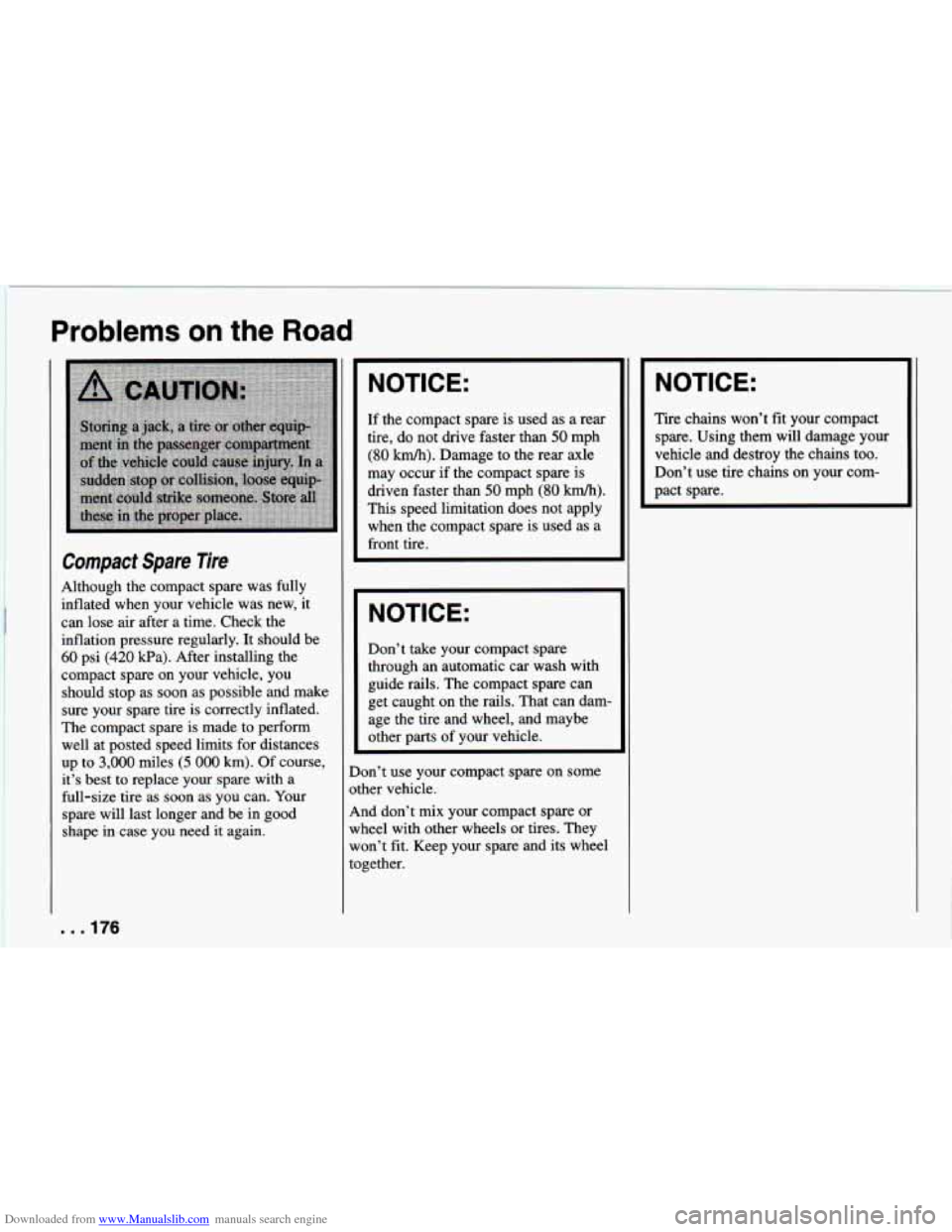
Downloaded from www.Manualslib.com manuals search engine Problems on the Road
Compact Spare Tire
Although the compact spare was fully
inflated when your vehicle was new, it
can lose air after a time. Check the inflation pressure regularly.
It should be
60 psi (420 Wa). After installing the
compact spare on your vehicle, you
should stop as soon as possible and make
sure your spare tire is correctly inflated.
The compact spare is made to perform
well at posted speed limits for distances
up to
3,000 miles (5 000 km). Of course,
it’s best to replace your spare with a
full-size tire as soon as you can. Your
spare will last longer and be in good
shape in case you need
it again.
NOTICE:
If the compact spare is used as a rear
tire, do not drive faster than
50 mph
(80 km/h). Damage to the rear axle
may occur if the compact spare is
driven faster than
50 mph (80 km/h).
This speed limitation does not apply
when the compact spare is used as a
front tire.
NOTICE:
Don’t take your compact spare
through an automatic car wash with
guide rails. The compact spare can
get caught on the rails. That can dam-
age the tire and wheel, and maybe
other parts of your vehicle.
Don’t use your compact spare on some
other vehicle.
And don’t mix your compact spare or
wheel with other wheels or tires. They
won’t fit. Keep your spare and its wheel
together.
NOTICE:
Tire chains won’t fit your compact
spare. Using them will damage your
vehicle and destroy the chains too.
Don’t use tire chains on your com-
pact spare.
. . .176
Page 179 of 292
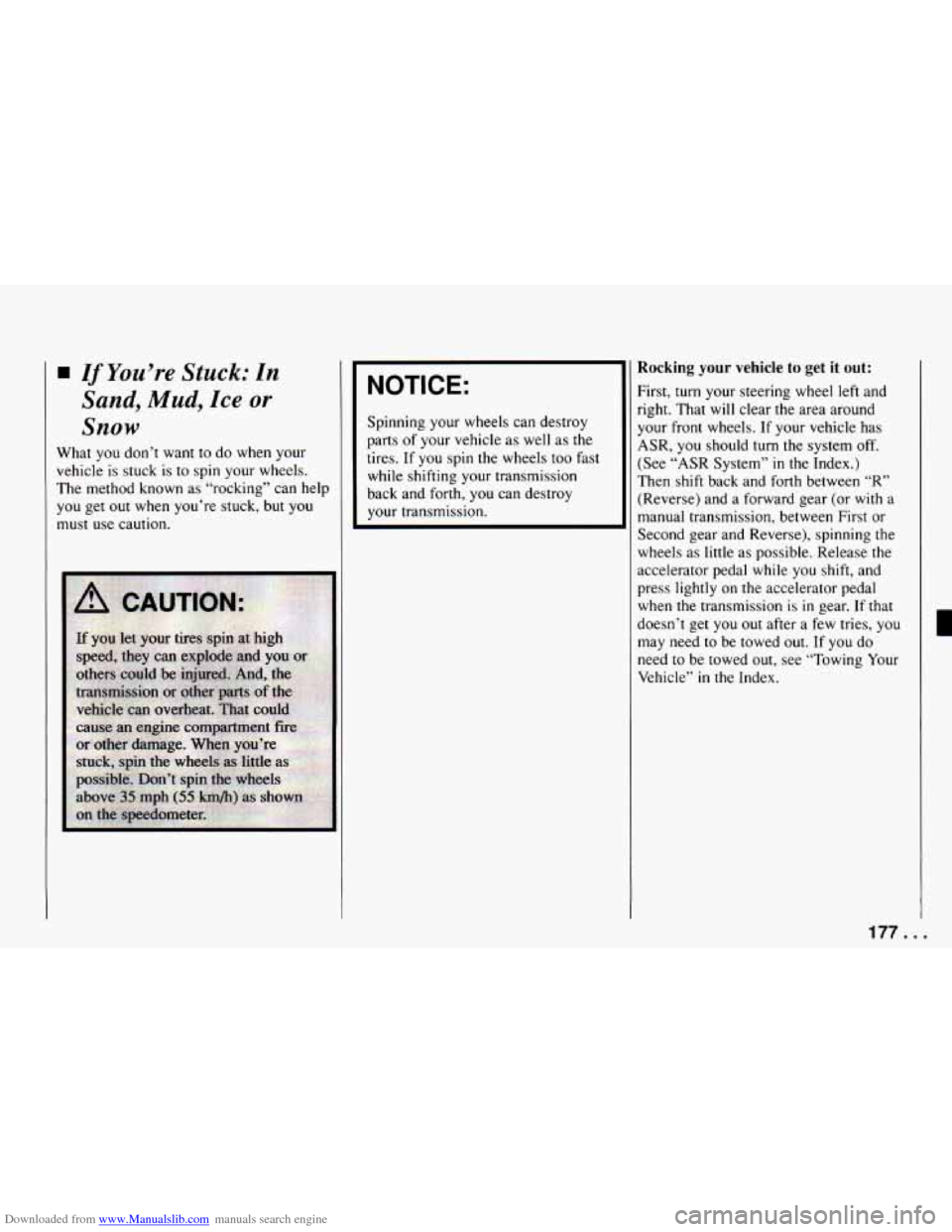
Downloaded from www.Manualslib.com manuals search engine If You’re Stuck: In
Sand, Mud, Ice or
Snow
What you don’t want to do when your
vehicle
is stuck is to spin your wheels.
The method known as “rocking” can help
you get out
when you’re stuck, but you
must use caution.
NOTICE:
Spinning your wheels can destroy
parts of your vehicle as well as the
tires.
If you spin the wheels too fast
while shifting your transmission
back and forth, you can destroy
your transmission.
Rocking your vehicle to get it out:
First, turn your steering wheel left and
right. That
will clear the area around
your front wheels.
If your vehicle has
ASR, you should turn the system off,
(See “ASR System”
in the Index.)
Then
shift back and forth between “R”
(Reverse) and a forward gear (or with a
manual transmission, between First or
Second gear and Reverse), spinning the
wheels as little as possible. Release the
accelerator pedal while you shift, and
press lightly on the accelerator pedal
when
the transmission is in gear. If that
doesn’t get you out after a
few tries, you
may need to be towed out.
If you do
need
to be towed out, see “Towing Your
Vehicle’’
in the Index.
177..
Page 180 of 292
Downloaded from www.Manualslib.com manuals search engine Problems on the Road
Trending: ESP, transmission, trunk release, brake fluid, relay, wiper size, radio
